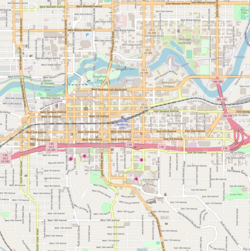Peyton Building and Peyton Annex | |
 The building in 2023 | |
| Location | 722 West Sprague Ave./10 North Post Street, Spokane, Washington |
|---|---|
| Coordinates | 47°39′27″N117°25′24″W / 47.65750°N 117.42333°W |
| Area | less than one acre |
| Built | 1898 |
| Architect | Cutter & Malmgren; Robert Sweatt |
| Architectural style | Romanesque, Early Commercial |
| NRHP reference No. | 05000191 [1] |
| Added to NRHP | March 15, 2005 |
The Peyton Building and Peyton Annex is a historic seven-story building and annex in Spokane, Washington. The building was designed by Cutter & Malmgren, and built in 1898. [2] It was built on the site of a former building known as the Great Eastern Building, designed by Herman Preusse and completed in 1890. [2] The annex was designed by Robert Sweatt, and built in 1908. [2] It has been listed on the National Register of Historic Places since March 15, 2005. [1]
